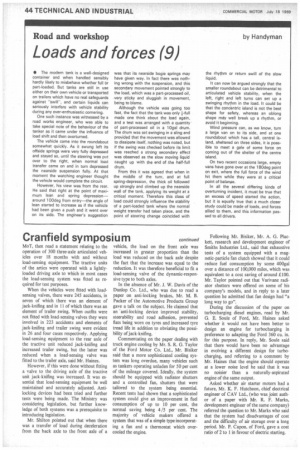Road and workshop
Page 46

If you've noticed an error in this article please click here to report it so we can fix it.
Loads and forces (9)
by Handyman
• The modern tank is a well-designed container and when handled sensibly hardly likely to misbehave whether full Or part-loaded. But tanks are still in use either on their own vehicle or transported on trailers which have no real safeguards against "swill", and certain liquids can seriously interfere with vehicle stability during any over-enthusiastic cornering.
One such instance was witnessed by a road works engineer, who was able to take special note of the behaviour of the tanker as it came under the influence of load shift and then overturned.
The vehicle came into the roundabout somewhat quickly. As it swung left its offside springs were very fully depressed and stayed so, until the steering was put over to the right, when normal load transfer came on and in turn depressed the nearside suspension fully. At that moment the watching engineer thought the vehicle would complete the circuit.
However, his view was from the rear. He said that right at the point of maximum lean and spring depression— around 100deg from entry—the angle of lean started to increase as if the vehicle had been given a push and it went over on its side. The engineer's suggestion was that its nearside bogie springs may have given way. In fact there was nothing wrong with the suspension, and this secondary movement pointed strongly to the load, which was a part-processed oil, very sticky and sluggish in movement, being to blame.
Although the vehicle was going too fast, the fact that the tank was only I-full made one think about the load again, and a test was arranged with a quantity • of part-processed oil in a 10gal drum. The drum was set swinging in a sling and provided that the movement was allowed to dissipate itself, nothing was noted, but if the swing was checked before its limit was reached a strong secondary effect was observed as the slow moving liquid caught up with the end of the half-full drum.
From this it was agreed that when in the middle of the turn, and at full spring-depression, the thick oil followed up strongly and climbed up the nearside wall of the tank, applying its weight at a critical moment. Therefore this class of load could strongly influence the stability of a part-loaded tank where the normal weight transfer had taken place, and the point of steering change coincided with the rhythm or return swill of the slow liquid.
It can now be argued strongly that the smaller roundabout can be detrimental to articulated vehicle stability, when the left, right and left turns can set up a swinging rhythm in the load. It could be that the concentric island is not the best shape for safety, whereas an oblong shape mdy well break up a rhythm, or avoid it beginning.
Wind pressure can, as we know, turn a large van on to its side, and at one roundabout which has a tall, central island, sheltered on three sides, it is possible to meet a gale of some force on coming out of the shelter of the centre island.
On two recent occasions large, empty vans have gone over at the 180deg point on exit, where the full force of the wind hit them while they were at a critical point of balanee.
In all the several differing kinds of overturning incident, it must be true that an excess of speed started the action, but it is equally true that a much closer study could be made of loads, and forces allied to them, and this information passed to all drivers.
















































































































